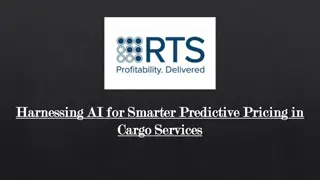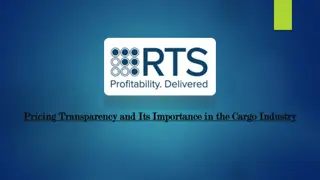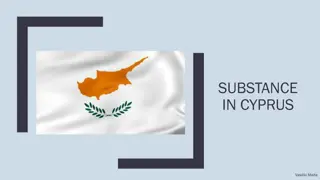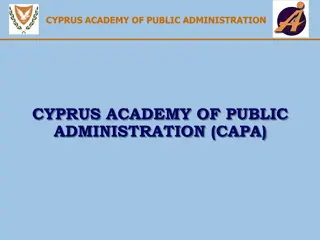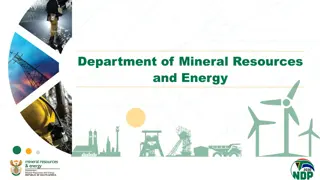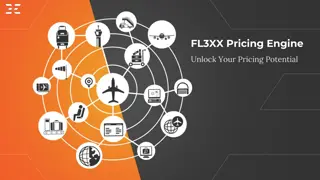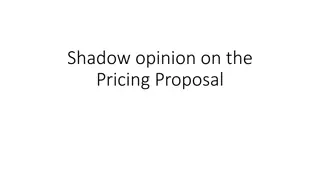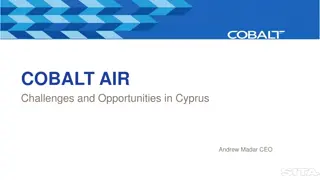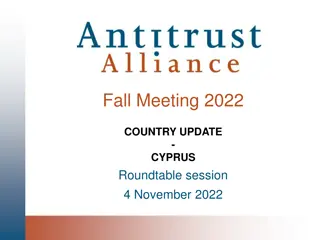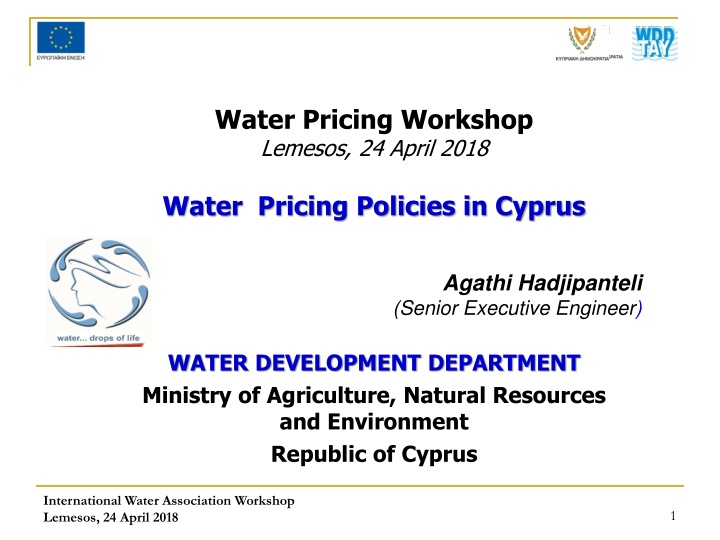
Water Pricing Policies in Cyprus - Challenges and Solutions
Water pricing policies in Cyprus face challenges due to water scarcity and high demand. The water sector overview reveals insights into water usage, resources, and historical facts. With a focus on institutional and legal frameworks, this workshop explores strategies to address water pricing challenges and ensure sustainable water management in Cyprus.
Download Presentation

Please find below an Image/Link to download the presentation.
The content on the website is provided AS IS for your information and personal use only. It may not be sold, licensed, or shared on other websites without obtaining consent from the author. If you encounter any issues during the download, it is possible that the publisher has removed the file from their server.
You are allowed to download the files provided on this website for personal or commercial use, subject to the condition that they are used lawfully. All files are the property of their respective owners.
The content on the website is provided AS IS for your information and personal use only. It may not be sold, licensed, or shared on other websites without obtaining consent from the author.
E N D
Presentation Transcript
Water Pricing Workshop Lemesos, 24 April 2018 Water Pricing Policies in Cyprus Agathi Hadjipanteli (Senior Executive Engineer) WATER DEVELOPMENT DEPARTMENT Ministry of Agriculture, Natural Resources and Environment Republic of Cyprus International Water Association Workshop Lemesos, 24 April 2018 1
Water Pricing Policies in Cyprus Cyprus Water Sector - Brief Overview Institutional and legal framework Water Pricing Policies Historical facts In accordance to the WFD 2000/60/EC Water Tariffs and other related measures Challenges LWB_IWA Workshop Lemesos, 24 April 2018 2
Water Sector Overview (1) Eastern Mediterranean, semi-arid region Classified as one of the water poor countries in Europe (with the highest exploitation index) Water resources rely on the highly variable rainfall Water resources are scarce and expensive to exploit Rainfall reveals a stepped drop in the last 50 years, leading to 40% surface runoff reduction. Water demand/supply rarely in balance condition Increased water demand and the climatic conditions led to severe water scarcity, with the demand by far surpassing available water quantities LWB_IWA Workshop Lemesos, 24 April 2018 3
Water Sector Overview (2) Inflow of Water to the Dams 250 2017-2018:38,8 MCM 191.8 200 168 MILLION CUBIC METRES Average 79 MCM 154 151 143 140 150 136 129 127 116.3 103 97 93.9 100 63 63 61 53 50 48.9 39 50 35 34 322526 24 19 17.9 12.9 12 0 1987-88 1998-99 2015-16 1988-89 1989-90 1990-91 1991-92 1992-93 1993-94 1994-95 1995-96 1996-97 1997-98 1999-00 2000-01 2001-02 2002-03 2003-04 2004-05 2005-06 2006-07 2007-08 2008-09 2009-10 2010-11 2011-12 2012-13 2013-14 2014-15 2016-17 HYDROLOGICAL YEAR ( 1 October- 30 September) LWB_IWA Workshop Lemesos, 24 April 2018 4
Water Sector Overview (3) Water Uses Livestock, 3.3% Industry, 3.0% Drinking Water (households etc; 29,6% Tourism; 4,9% Irrigation (agriculture & other), 59.1% LWB_IWA Workshop Lemesos, 24 April 2018 5
Water Sector Overview (4) Water Resources Natural Water Resources Groundwater: Used to be the most obvious accessible source. Today, GW aquifers are highly overexploited and deteriorated and piezometric levels decrease rapidly, with seawater intrusion. Today, GW serve; 10% - 15 % of the total domestic water supply Up to 60% of the total irrigation use Governmental Water Works (1970-2010) (dams on almost all watercources, conveyors & other infrastructure, water treatment plants, distribution networks etc). They serve; 85% - 90% of the total domestic water supply Up to 40% of the total irrigation use (irrigation demand is rarely satisfied, according to the yearly allocation scenarios from GWW) LWB_IWA Workshop Lemesos, 24 April 2018 6
Water Sector Overview (5) Water Resources Non Conventional Water Resources Despite the supply and the demand management measures, the adverse climatic conditions and the increase in demand necessitated the use of non-conventional water resources Desalination: Desalinated water is BOOT contracts and allocated through the GWP for the supply of drinking water. Despite the environmental and financial cost, desalination is necessary to satisfy the demand during dry years and to increase water security. Water Reuse - Tertiary treatment of sewage effluent: A highly stable source, with significant environmental benefits. Used for irrigating agricultural crops (under specific quality standards and code of agr. practice). Also used for irrigating green/recreational areas as well as for GW aquifers recharge. LWB_IWA Workshop Lemesos, 24 April 2018 7
Water Sector Overview (6) GWW Domestic Water Supply 100 90 80 1811 70 2 MILLION CUBIC METRES 33 38 8 3 60 3126 27 68 53 48 9 68 29 223030 50 5 33 49 5 12 11 6 14 14 40 1719 11 1717 30 15161413 19 59 7 1816 2019 52 8 2417 5 4238 20 12 5 35 36 29 30 11 2126 2326 2017 182024 10 1621 12 141721 1417 15 8 0 91 92 93 94 95 96 97 98 99 0 1 2 3 4 5 6 7 8 9 10 11 12 13 14 15 16 17 Dams Boreholes Desalination Plants Notes: 1991-2018: new resources (new large GWW. 1997: Desalination) gradually new local authorities are connected to the GWW LWB_IWA Workshop Lemesos, 24 April 2018 8
Water Sector Overview (7) Water Resources Along with the development of GWW, a number of demand management measures were applied. e.g. efficient distribution systems and advanced irrigation systems, metering and volumetric pricing, overconsumption levy, people s awareness etc. In order to cope with the limited available water quantities, water restrictions are implemented via a yearly allocation policy, used to ensure water availability to the different uses, by priority. Drinking water 100% Recharge downstream of the dams Quantities kept for future needs Irrigation (permanent crops, greenhouses, seasonal crops, other green urban areas etc) 9
Water Sector Overview (8) Water Allocation from GWW 170 160 150 140 130 6155 120 MILLION CUBIC METRES 110 484854655356 546169634936 100 90 30 80 42 61 52 21 70 3729 5353 60 2826 29 41 50 363135 37464945 4348 485863666973 74 74637082 8179,678 80 829094 40 30 20 10 0 91 92 93 94 95 96 97 98 99 0 Domestic 1 2 3 4 5 6 7 8 9 10 11 12 13 14 15 16 17 Recharge Irrigation Irrigation: appr. 17 mcm come from recycled water Notes: 1991-2010: new resources; SCP, Arminou dam & Dhiarizos div., Kannaviou dam 1997: Desalination (increasing), 2000: Recycled water (increasing) LWB_IWA Workshop Lemesos, 24 April 2018 10
Institutional and Legal framework (1) Water Services and Providers Dams Recycled Water Desalination GOVERNMENTAL WATER WORKS (WDD) Drinking Water Local Water Authorities (in bulk) Irrigation Water (retail basis from GWW) and Local Irrigation Organizations OTHER SOURCES (Surface & Groundwater) Domestic Water users LWB_IWA Workshop Lemesos, 24 April 2018 11
Institutional and Legal framework (2) Water Service Providers Water Development Department: Development, management and protection of the water resources according to the European and National legislation. Priority: the satisfaction of the water needs for all uses. Distribution of water through the GWW Potable water supply to Local Authorities in bulk Irrigation water from dams to the end users & Irr. Org. recycled water for irrigation to the end users & Irr. Org. Permit and audit the singing of wells and regulate the abstraction according to the status of the aquifer. Develop and apply water policy and water pricing, after the approval of the Minister of Agriculture Rural Development and Environment and the Council of Ministers according to the national law. LWB_IWA Workshop Lemesos, 24 April 2018 12
Institutional and Legal framework (3) Water Service Providers Local Water Authorities (potable water suppliers to the end user) Water Boards of Nicosia, Lemesos & Larnaca areas Prices were voted by the Parliament until 2009. Since 2009 they are only approved by the CoM. Municipalities: Prices are approved by the Ministry of Interior, after the proposal of the local council. Communities: Prices are approved by the District Officer, after the proposal of the local council. Since 2014 proposals must have the consent of WDD Local Irrigation Organizations: Water prices are applied according to each Organization s Regulations, voted by the Parliament LWB_IWA Workshop Lemesos, 24 April 2018 13
Water Pricing Policies - Historical facts (1) Water pricing has been practiced for decays (since the 60 s). Originally as fixed tariff / time / area. Volumetric pricing was applied gradually (70 s 80 s) with the implementation of the Governmental Water Works or the Irrigation Organizations networks, according to the water management regulations voted by the Parliament, for their establishment and management. With Development Projects, after the finance or supervision of international organizations (IBRD, FAO-UN) pricing policies and associated measures (e.g. metering and advanced irrigation technologies) have been a constituent part of the projects planning. the implementation of the Intergraded Rural LWB_IWA Workshop Lemesos, 24 April 2018 14
Water Pricing Policies - Historical facts (2) 1989: Loan Agreements with the World Bank (IBRD) and the Kuwait Fund, for the financing of the SCP, required WDD to set water tariffs to satisfy specific requirements. The National Law was revised accordingly. Borrower shall introduce a unified tariff for bulk water in the domestic sector that should be sufficient to cover the full O&M cost and debt service requirements or depreciation, whichever is the higher and take into account any shortfall/surplus Borrower shall establish charges for irrigation water which shall be sufficient to cover 38% of the weighted average unit cost of water Take account of the importance of the primary sector, food security, preservation of rural landscape, avoidance of urbanization etc. Most GWPs were part of Integrated Rural Development Projects or planned to support rural agricultural activities. Gradually, domestic water supply has gained priority, as the potable water resources of the LWA were depleted. LWB_IWA Workshop Lemesos, 24 April 2018 15
Water Pricing Policies - Historical facts (3) The Water Framework Directive (2000/60/EK) Article 9: Pricing Policies is one of the basic measures to ensure effective use and sustainability Take account of the principle of cost recovery of water services including the environmental and recourse cost Provide incentives to use water efficiently Ensure adequate contribution of the different water uses to the cost of water services Have regard to the effects of the recovery & local conditions Exemptions: report the reasons and ensure that it fulfills the objectives of the Directive Water Scarcity & Droughts, EC COM 2007 Other related measures (e.g. metering, volumetric pricing) LWB_IWA Workshop Lemesos, 24 April 2018 16
Water Pricing Policy Regulations in accordance to WFD Art.9 & CY N14(I)/2004 (1) Regulations 128/2014 were voted by the Parliament in Feb.2014, after the special study and the relevant public consultation process, 2009-2010. They are the legal framework for the pricing policies to be adopted by all water service providers, towards WFD Art.9 implementation. They: Determine the water services and water uses Introduce the Environmental & Resource Cost (ERC) pricing to all uses and define financial cost Establish the basic principles to be applied by all water service providers, in order to fulfill the Art.9 requirements, taking into account the institutional framework for the management of water resources. LWB_IWA Workshop Lemesos, 24 April 2018 17
Water Pricing Policy Regulations in accordance to WFD Art.9 & CY N14(I)/2004 (2) Domestic Water Sector Full Cost Recovery on GWW level Cost = capital + O&M + ERC + purchase of water from desalination (BOOT agreements) Uniform Price from GWW to Local Water Authorities Full Cost Recovery on Local Water Authorities Level Cost = purchase cost (from WDD or from own resources) + capital + O&M + ERC Differentiated price from Local Authorities to end users Rising Block tariffs to the end users for efficient use Different blocks for uses/users with higher needs LWB_IWA Workshop Lemesos, 24 April 2018 18
Water Pricing Policy Regulations in accordance to WFD Art.9 & CY N14(I)/2004 (3) Irrigation Water Sector: Adequate contribution Fresh Water from GWW Uniform pricing from GWW to all areas Overconsumption levy for quantities exceeding the allocated according to the yearly scenario Tertiary Treated Recycled Water Provides significant benefits to the environment and the water balance Give motives to use with lower prices compared to the fresh water prices Private groundwater / surface water abstraction Pay for the ERC LWB_IWA Workshop Lemesos, 24 April 2018 19
Water Prices from GWW and ERC for abstraction from other sources Legal Procedure for Approval after 2014 Water prices, for the supply of water from GWW and for the ERC for abstraction from other resources, are decided according to the Integrated Water Management Law, based on the principles of the Water Pricing Policy Regulations (Art.9, 128/2014). Proposal made by WDD to the Minister of ANR&Env. Decisions made by the Council of Ministers. The Council of Ministers has to take into consideration (but not obligatory accept) the opinion of the Water Management Advisory Committee, which is composed by the interested stakeholders representatives (governmental departments, water suppliers, water users, interested NGO s and environmentalists). LWB_IWA Workshop Lemesos, 24 April 2018 20
Water Prices 2017 Price /m3 ERC Cost /m3 Domestic Water Tariffs Financial Total Financial ERC Total Governmental Water Works to Local Water Authorities Areas of Nicosia, Lemesos, Larnaca & Ammochostos 0,77 0,05 0,82 0,80 0,05 0,85 Pafos city and villages Abstraction from own resources (GW & surface) 0,59 0,05 0,64 To Local Water Authorities - 0,05 - 0,05 0,05 0,05 To Water Bottlers - 0,12 - 0,12 0,12 0,12 Cost = capital (infrastructure replacement cost) + O&M + desalination + ERC Capital cost includes the cost of basic infrastructure, e.g. dams. Assumption: 50% or 60% of domestic water is purchased from desalination LWB_IWA Workshop Lemesos, 24 April 2018 21
Water Prices 2017 Price /m3 Cost /m3 Irrigation Water Tariffs Financial ERC Total Financial ERC Total Governmental Water Works For agricultural production Overconsumption For community green areas For private green areas For the abstraction from groundwater & surface water For agricultural production For community green areas For private green areas 0,15 0,34 0,21 0,34 0,02 0,11 0,02 0,02 0,17 0,45 0,23 0,36 0,34 0,11 0,45 - - - 0,01 0,02 0,10 - 0,01 0,02 0,10 0,19 0,19 - Cost = Capital (infrastructure replacement cost) + O&M + ERC Capital cost includes the cost of basic infrastructure, e.g. dams. A politicoeconomic approach, not to cause great disruption in the sector. Account of the social & environmental importance of the primary sector and that DWS is fully satisfied LWB_IWA Workshop Lemesos, 24 April 2018 22
Domestic Water Tariffs from GWW to LWA 1.00 0.90 0.80 0.70 0.82 0.60 0.77 0.50 0.57 0.40 0.46 0.37 0.30 0.20 0.10 0.00 LWB_IWA Workshop Lemesos, 24 April 2018 23
Yearly Cost of Water Supply for a medium Household (VAT not included) Consumption per 2 months Local Water Authority Block Tariffs /m3+ fixed 30m3 40m3 60m3 80m3 URBAN AREAS (Water Boards) Water Board 1 Water Board 2 1,00 to 3,00 + 8.00 0,90 to 5,00 + 22.00 258 261 348 348 588 642 888 1,242 Municipalities served by GWW Municipality 1 Municipality 2 0,80 to 4,50 + 12.00 1,00 to 3,00 + 8.00 204 258 276 348 648 588 1,140 888 Communities served by GWW Community 1 Community 3 1,10 to 3,60 + 5.25 0,76 to 3,50 + 5.00 230 167 229 223 470 540 902 960 Communities served by own resources (Groundwater or Surface waters) Community 1 0,30 to 1,40 + 10.00 Community 2 0,05 to 1,00 + 10.00 Community 3 0,20 to 3,00 + 2.00 Community 4 0,45 to 3,00 + 5.00 72 61 44 107 144 126 70 160 312 158 107 218 480 278 187 308 24
Facts and Challenges Acceptance of water pricing in Cyprus is high but it has lesser impact on water use than other efficiency techniques. Water shortage makes price elasticity very low, especially in agriculture. Price signals would do nothing if not combined together with other demand management measures. Metering and volumetric pricing Advanced irrigation technologies & on farm equipment (in the 80/ 90s irrigation efficiency initiatives were funded by the Rural Development programmes, resulting in a massive uptake of advanced irrigation technologies by farmers and other users. Advanced technologies in the domestic sector Public awareness (it must be continuous and evolving) Groundwater abstraction control Losses/unaccounted quantities (especially on LWA level) Cropping pattern modification(needs intergraded approach) LWB_IWA Workshop Lemesos, 24 April 2018 25
Facts and Challenges Water resources are a social commodity with strong relation to nature and environment, highly important to public health, well established concepts of rights and wellness. Scarcity acts as a limiting constraint for economic activities, mainly agriculture. Therefore the allocation of available quantities is a permanent problem that puts demand management under continuous discussion, strongly related to pricing. Water pricing is a socioeconomic measure, strongly dependent on political will, in all levels of the system. Need more integration between different stakeholders as well as policy streams for more efficient pricing policy decisions and effectiveness of the measure, always combined with other measures and policies. LWB_IWA Workshop Lemesos, 24 April 2018 26
Thank you for your attention! ahadjipanteli@wdd.moa.gov.cy www.moa.gov.cy/wdd 27 LWB_IWA Workshop Lemesos, 24 April 2018

